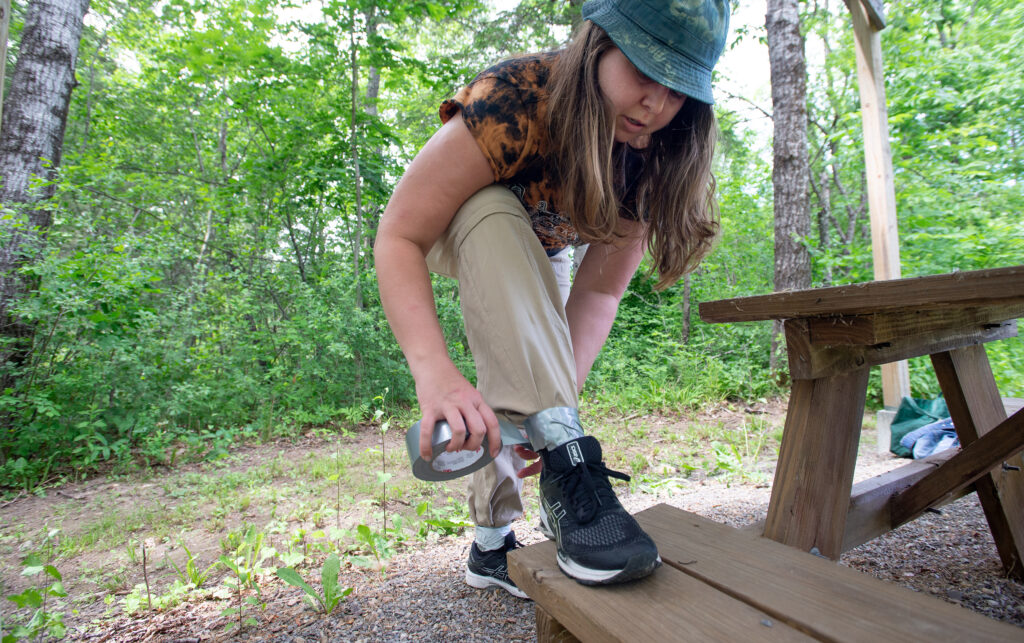
Use this duct tape trick to protect yourself from tick bites
By Sam Schipani, Bangor Daily News Staff
With ticks on the rise in Maine this year, intrepid outdoorsy folks are getting creative with methods for keeping ticks at bay. Among the methods circulating via popular social media sites is to wrap duct tape with the sticky side out around pants ankles to catch ticks while they try to crawl up legs.
It looks silly, sure. But does it work?
Griffin Dill, who manages the University of Maine Cooperative Extension Tick Lab, said that it’s not a terrible idea, as long as the tape is snug enough that the ticks can’t get underneath it.
“I have seen this trick circulating online, particularly through social media,” Dill said. “A primary focus of tick bite prevention is creating a barrier that will prevent the tick from accessing bare skin. Wrapping a layer of sticky tape around your ankles will not completely prevent tick bites, but any added barrier can help.”

TICK TRICK — BDN reporter Sam Schipani wraps the bottoms of her pants with duct tape to help prevent ticks from crawling up. With ticks on the rise in Maine this year, some people are trying the duct tape technique where you wrap duct tape with the sticky side out around the ankles of pants to catch ticks while they try to crawl up legs.
The placement of the duct tape is key because it targets a place where ticks often climb onto bodies.
Chuck Lubelczyk, vector ecologist at Maine Medical Center Research Institute, said most tick encounters happen below the knee.
“Especially on hot days like the last couple of days, ticks are really close to the ground,” Lubelczyk said. “A lot of moisture is trapped around the ground level, which makes the ticks very happy. They tend to really get on people at the ankle height and crawl up pant legs. Anything you can do to close your pant legs will help.”
Dill explained that if you have found ticks on your back, neck or head, they likely climbed up from your ankles, so the extra ankle protection is even helpful to keep ticks away from your upper body.
“Ticks have a natural inclination to climb up on a host, so if they don’t immediately encounter exposed skin they will generally travel up until they do,” he said. “Dog ticks in particular are known to climb up and become attached high on the body, especially around the neck and head. Ultimately, the concern isn’t necessarily keeping the ticks from falling down your shirt, but keeping them from accessing exposed skin on their way up the body.”
That said, the method isn’t perfect. Durability of the tape, for instance, can be an issue.
“I wouldn’t probably do that if I were doing any kind of real hiking or bushwhacking, or people that are going out for extensive hikes and stuff,” Lubelczyk said. “I would see that stuff coming apart if you’re out walking in the brush heavily. If it’s raining it might get wet and may not be effective. I think people should be aware.”
If you’re looking for a more effective way to keep ticks away, try gaiters for your ankles and legs, Lubelczyk said.
“A few brands are selling light colored ones that they have treated with permethrin and they’re meant as a blocker for chiggers and ticks getting on people,” Lubelczyk said.
Duct tape around the ankles should also only be used alongside other tick prevention measures, not in their place.
“Although the use of tape may not be a silver-bullet solution, by combining this method with other prevention strategies, like protective clothing, repellents and conducting frequent tick checks, the risk of a tick bite can be reduced,” Dill said.
And, of course, Lubelczyk said to never use duct tape to remove a tick, as the imprecise yanking could leave parts of the tick’s body behind
“There are a lot of great tick removal tools out on the market,” Lubelczyk said. “If you don’t have access to a pair of very fine tweezers, a lot of the tick spoons work very well.”